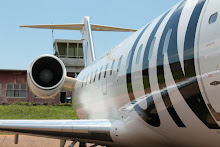Miscellaneous Ramblings
Well, I'm done flying for now. I have met all the requirements to file form 8710 and request a check ride from a DPE. Now all I need to do is study, study and study some more. My main course of study will be the ASA Oral Exam Guide and PTS as well as some systems literature I've gathered for the ancient "Hershey Bar" winged Arrow I's that will be used for the flight.
The last flight went well. There had been rain the night before and the ceiling was broken at 3,500 and improving at departure time. It was high enough to do eights on pylons and a bunch of landing practice. When we got out towards the practice area, there was a large enough break in the clouds for us to climb VFR. Here's a rare photo of Phoenix from above the clouds. Sorry for the quality, it was taken from my smart-phone.

Afterwards, we decided to head to Phoenix Regional (A39). As I've said before, it's a modest facility. It has a 50'x5,000' runway 3/21 that is in marginal condition with no markings other than faded numbers. Most of the time, winds favor runway 21 - which has 20'+ tall trees right at the approach end. So most landings must be treated as 50' obstacle landings.
The DPE that will most likely be doing my check-ride loves to take candidates to Phoenix Regional at 5,500 and cut the engine for a steep spiral down and transition to a power off 180. I've done about 20 of them there and have about a 90% ratio on the numbers so I'm pretty confident about that. I've also been practicing soft field landings on point and short fields. The PTS doesn't require a point for soft field landings, but I figure if I can do that, then a standard short field should be a piece of cake.
One of my concerns was calculating pivotal altitude for eights on pylons in the aircraft. Thanks to John (Aviation Mentor) for a good pointer. I'll just make a chart based on a variety of air speeds. If the DPE asks, I'll just as him which airspeed and voila, there it will be.
The only flight stuff to brush up on is emergency procedures and diversions (which are easy with a properly done flight plan).
My friend Dana is coming over tonight to help me study for the oral exam. She's a CFI and knows her stuff. I'm glad she can help. Next month, she'll probably have an airline job. She has 3 interviews scheduled in January.
If all goes well, I should be ready for my Commercial Single check ride on or about next Saturday, January 6th.
---
The other day, I took my middle son to Wickenburg with me. Out of the three kids, he's been the most timid about flying. I was proud of him. He sat in the front seat of the 172 and spent the entire flight both ways with his face pressed against the window pointing out things below.
When we arrived in Wickenburg, we parked next to an Archer II with a very nice paint job. Other than the bent empennage and the 4 foot gash in the right wing between the aileron and flap, it was a nice plane. The undercarriage and nose were in tact and it didn't look at all like damage from a bad landing. How did a damaged Archer get there?
The local A&P came out to say hello and told me the story:
The plane came in on December 22nd from California carrying a couple visiting Wickenburg for the holidays. The tied down at the transient parking area and left on their merry little way. The next day, a local who owns a Cessna 170 decided to go solo flying. From what I hear, he found the battery to be dead. Keep in mind, I don't know whether a 170 has a parking brake or not. Since he was flying solo, the obvious thing to do was hand prop it. I don't know if chocks were used or not, but when the plane started...it really started. It got away from him so fast that he couldn't get in the door.
The 170 picked up speed as it rolled across the apron to the transient parking area where it promptly smashed in to the Archer, totalling it. I didn't see the 170, but heard that the damage was minimal.
Of course the owner of the 170 wasn't insured. Also, the couple who own the Archer couldn't be reached. As of the 27th, they still didn't know that their pristine Archer was a total loss. On their aircraft was a note, giving the name of the owner of the 170 and stating in big letters: "SORRY FOR THE INCONVENIENCE". Inconvenience? A flat tire is an inconvenience. Even a damaged prop might pass as an inconvenience. A total loss? I would call that a FUBAR.
I'm sure the Archer owners were insured, but it is aircraft insurance after all. I'm also pretty sure there's going to be some lawyerin' going on.
I didn't have a camera. If the plane is still there next week, I'll take some photos and post them.
This is one of those classic situations where my favorite poster from Despair, Inc. comes to mind:
 What do you say to the 170 owner other than, "It must really suck to be you right now."
What do you say to the 170 owner other than, "It must really suck to be you right now."
No comments:
Post a Comment